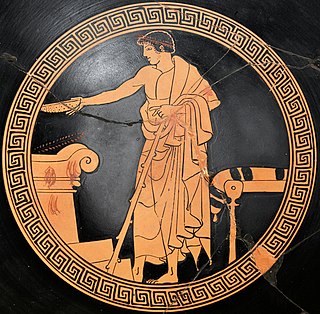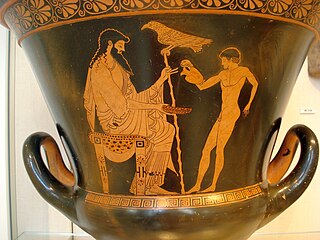
Black-figure pottery painting, also known as the black-figure style or black-figure ceramic, is one of the styles of painting on antique Greek vases. It was especially common between the 7th and 5th centuries BC, although there are specimens dating as late as the 2nd century BC. Stylistically it can be distinguished from the preceding orientalizing period and the subsequent red-figure pottery style.
Kleitias was an ancient Athenian vase painter of the black-figure style who flourished c. 570–560 BCE. Kleitias' most celebrated work today is the François Vase, which bears over two hundred figures in its six friezes. Painted inscriptions on four pots and one ceramic stand name Kleitias as their painter and Ergotimos as their potter, showing the craftsmen's close collaboration. A variety of other fragments have been attributed to him on a stylistic basis.

The Kleophrades Painter is the name given to the anonymous red-figure Athenian vase painter, who was active from approximately 510–470 BC and whose work, considered amongst the finest of the red-figure style, is identified by its stylistic traits.

Euphronios was an ancient Greek vase painter and potter, active in Athens in the late 6th and early 5th centuries BC. As part of the so-called "Pioneer Group,", Euphronios was one of the most important artists of the red-figure technique. His works place him at the transition from Late Archaic to Early Classical art, and he is one of the first known artists in history to have signed his work.

Douris or Duris was an ancient Athenian red-figure vase-painter and potter active c. 500 to 460 BCE.

Lydos was an Attic vase painter in the black-figure style. Active between about 560 and 540 BC, he was the main representative of the '’’Lydos Group’’’. His signature, ό Λυδός, ho Lydos ", inscribed on two vases, is informative regarding the cultural background of the artist. Either he immigrated to Athens from the Lydian empire of King Kroisos, or he was born in Athens as the son of Lydian parents. In any case, he learned his trade in Athens.

Epiktetos was an Attic vase painter in the early red-figure style. Besides Oltos, he was the most important painter of the Pioneer Group. He was active between 520 BC and 490 BC. His name translates as "newly acquired", which is most probably a reference to his slave status.

The Antimenes Painter was an Attic vase painter of the black-figure style, active between circa 530 and 510 BC.

Makron was an ancient Greek vase painter active in Athens ca. 490–480 BC. Though only one signed example of his work is known to have survived, some 350 vases have been attributed to him by Sir John Beazley, making him one of the best surviving painters of the red-figure period.

Onesimos was an ancient Athenian vase painter who flourished c. 500–480 BC. He specialized in decorating cups, mostly of Type B, which comprise virtually all known examples of his work.

Psiax was an Attic vase painter of the transitional period between the black-figure and red-figure styles. His works date to circa 525 to 505 BC and comprise about 60 surviving vases, two of which bear his signature. Initially he was allocated the name "Menon Painter" by John Beazley. Only later was it realised that the artist was identical with the painters signing as "Psiax".

The Brygos Painter was an ancient Greek Attic red-figure vase painter of the Late Archaic period. Together with Onesimos, Douris and Makron, he is among the most important cup painters of his time. He was active in the first third of the 5th century BCE, especially in the 480s and 470s BCE. He was a prolific artist to whom over two hundred vases have been attributed, but he is perhaps best known for the Brygos Cup, a red-figure kylix in the Louvre which depicts the "iliupersis" or sack of Troy.

The Amasis Painter was an ancient Greek vase painter who worked in the black-figure technique. He owes his name to the signature of the potter Amasis, who signed twelve works painted by the same hand. At the time of the exhibition, "The Amasis Painter and His World" (1985), 132 vases had been attributed to this artist.

The Varrese Painter was an Apulian red-figure vase painter. His works are dated to the middle of the 4th century BC.

Eucharides Painter is the common nickname of an ancient Greek artist who decorated but did not sign Attic vases. Neither his real name, nor the dates of his birth and death are known. Presumably this artist was a pupil of the Nikoxenos Painter.

The Altamura Painter was a classical Greek vase painter. Today about 127 different vases are attributed to him. Many of them were different types of pottery, such as amphorae, kraters, pelikei, and many others. The Altamura Painter's pottery work is dated from 475 BC to 425 BC. He mostly painted mythical gods and goddesses, as well as ordinary people.

Tleson was an Attic potter and perhaps also a vase painter in the black-figure style. He was the son of the famous potter Nearchos and brother of Ergoteles. His workshop apparently produced mostly Little-master cups. Most of his vases were painted by the Tleson Painter, whose real name is unknown, and whose conventional name is derived from Tleson. Based on the fact that vases known by that hand so far are only ever signed by Tleson, John Beazley suggested that Tleson and the Tleson painter may be identical. There is no proof for this hypothesis. Some of Tleson's pots were painted by other artists, such as Oltos and the Centaur Painter.

Skythes was an Attic black-figure and red-figure vase painter active between about 520 and 505 BC.

The Lysippides Painter was an Attic vase painter in the black-figure style. He was active around 530 to 510 BC. His conventional name comes from a kalos inscription on a vase in the British Museum attributed to him; his real name is not known.


















